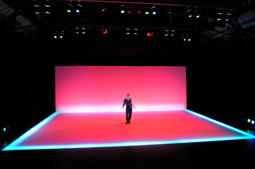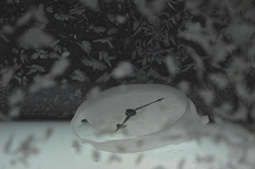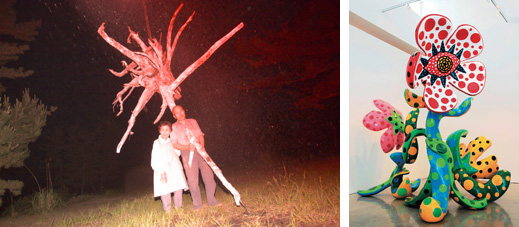 |
Focus features two in-depth reviews each month of fine art, architecture and design exhibitions and events at art museums, galleries and alternative spaces around Japan. The contributors are non-Japanese art critics living in Japan. |
|
|
 |
 |
 |
Arts and Cities: Aichi Triennale 2010
Lucy Birmingham |
 |
 |
|
 |
| Oriza Hirata + Ishiguro Laboratory (Osaka University), "Hataraku Watashi (I, Worker)" (2008) |
|
Hiroaki Umeda, "Haptic"; photo courtesy of Shin Yamagata |
For performing and visual artists in Japan, securing financial backing is a never-ending challenge, made even more difficult by the tight economy. Unlike in Europe and the U.S., generous art patrons in Japan are few, in part because of a lack of tax advantages. Government support has been notoriously limited. So when an avid art patron like Masaaki Kanda, governor of Aichi prefecture, steers government funds into the arts, it's cause for celebration. And what a celebration it is: the inaugural Aichi Triennale 2010 in Nagoya is already underway and continues until 31 October. Backed by 70% funding from the prefecture, it is an unprecedented 72-day gathering of about 80 world-class Japanese and international artists in the performing and fine arts. The majority of performances are either Japan or world premieres. Several well-known international curators have been involved in making the artist selections.
"The Aichi Triennale is probably the first of its kind in Japan, with the most financial support among the biennales and triennales," says Artistic Director Akira Tatehata. "Our first target is local residents who are ordinary people outside of the art world, but of course we also hope to get Korean, Chinese, Taiwanese and Western visitors," he adds. "If we can attract 300,000 visitors, then we've succeeded."
With an "Arts and Cities" theme, the organizers are focusing on local participation as a way to boost the local economy. As the home of Toyota, the area has been hit hard by the economic downturn, worsened by the carmaker's manufacturing scandals. Venues throughout downtown Nagoya will be used, including the Choja-machi area, still an important wholesale textile district.
The emphasis is on cutting-edge, crossover works. Performances will number close to 60, and include five theater companies and the opera Les Contes D'Hoffman, sung in French with Japanese subtitles. During the "Festival Week" of 11-17 October, there will also be ballet, kabuki, taiko drumming and other classic performances with a contemporary edge. Most events will be held at the Aichi Arts Center, the region's showcase cultural-arts complex.
The participant who probably best defines the triennale's artistic crossover theme is Japanese multi-media artist and dancer Hiroaki Umeda, 33. His riveting performances combine digital light, sound and solo dance. Although self-taught, he has garnered high praise at both digital arts events and theater festivals abroad, where he spends most of his time. Umeda will be performing "Adapting for Distortion" and "Haptic" on 11 and 12 September. His video installation "Untitled" will be on display at the Nayabashi site throughout the triennale, as part of the visual art exhibitions.
The art exhibitions, on display until 31 October, also offer a wide and intriguing selection of creators' works. Art-star headliners include Cai Guo-Qiang with "Painting," one of his iconic gunpowder works, and Yayoi Kusama, Japan's queen of dots, with "Sculpture." Both are showing at the Aichi Arts Center.
|
 |
|
Aiko Miyanaga, "color of silence (clock)" (2009), naphthalene |
Others artists featured at the Aichi Arts Center include Bangladesh-born Firoz Mahmud with his installation "Sucker' wfp21" -- a fighter jet covered in beans symbolizing disproportionate government spending on militarism rather than needed food programs. Japanese art photographer Lieko Shiga's "Portrait of Land Reclamation -- Expanding Bloodlines" is a series of sensitive but eerie portraits of aging residents in the small Japanese village where she has been living since 2009. Aiko Miyanaga's naphthalene installation "yu (ties)" fascinates as it fades with time -- the art of disappearance.
At the Choja-machi site, Welsh-born, London-based installation artist Cerith Wyn Evans is showing "299792458 m/s," one of his popular works of light using neon tubes.
On show at the Nagoya City Art Museum are works by 12 artists, including American Tom Friedman, known for recreating everyday materials into finely crafted conceptual sculptures; the foursome Gelitin from Vienna with their humor-infused installations; Japanese Chiharu Shiota, inspired by her dreams to create dramatically layered, labyrinthine installations; Mexican-born, Brazil-based Hector Zamora with a hammock installation at the museum entrance and also sculptures at the Aichi Arts Center.
The Aichi Triennale is art fever at its best. Catch it while you can.
 |
left: Yayoi Kusama, "Footprints of Life" (2010), installed in Oasis 21, a facility next to Aichi Arts Center, Nagoya
right: Firoz Mahmud, drawing plan for "Sucker' wfp21" (2009-10)
|
 |
left: Lieko Shiga, "Portrait of Land Reclamation -- Expanding Bloodlines," from The Annals of Kitakama Village series (2009)
right: Yayoi Kusama, "FLOWERS THAT BLOOM AT MIDNIGHT" ©Yayoi Kusama, Yayoi Kusama Studio Inc.; courtesy of Gagosian Gallery / Ota Fine Arts
All images courtesy of Aichi Triennale 2010 except where otherwise noted
|
|
 |
 |
Lucy Birmingham
Based in Japan for almost 25 years, Lucy Birmingham has written for Newsweek, Bloomberg News, Architectural Digest, The Boston Globe, Artinfo.com, Artforum.com, and ARTnews, among other publications. As a photojournalist her work has appeared in The New York Times, Business Week, Forbes, Fortune, U.S. News and World Report, and A Day in the Life of Japan. She is also a scriptwriter and contributing editor at NHK, Japan's public broadcaster, and has published several books including Old Kyoto: A Guide to Traditional Shops, Restaurants, and Inns. |
|
 |
|